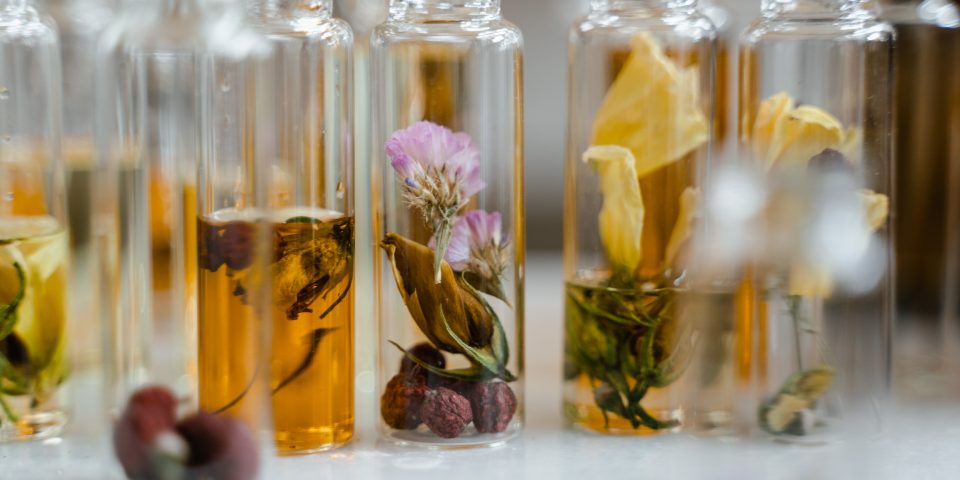What are Essential Oils?
“Essential oils” is an umbrella term used to describe highly hydrophobic liquid containing volatile, concentrated, steam-distilled or cold-pressed extracted chemical compounds of almost any part of a plant, such as seeds, flowers, fruit, leaves, stems, resins and roots.
Essential oils have revered for centuries for their restorative properties on the mind, body, and spirit for improving physical and psychological well-being. Essential oils are also commonly known as volatile oils, or simply called by their name, for example, Clove Essential Oil.
Essentials oils are used both personally and commercially and are used in perfumes, cosmetics, soaps, air fresheners and other products, for flavoring food and drink, and for adding scents to household cleaning products. It is, however, more common that synthetic fragrance notes are added to these items as the petrochemical synthetic fragrances are less costly than a pure essential oil.
You are able to bring the healing power of all that God has made directly into your home.
Each Essential Oil Has its Unique Fragrance
Each essential oil has different chemical and aromatic properties, and it is this essential oil which gives a plant its scent, which is often used protect it from predators, or hazardous environmental conditions. Some of the aromatic scents help the plants and flowers with the pollination process. The chemical composition of each essential oil varies within the same plant species, and from plant to plant.
Extracting the Oil from the Plant
Essential oils can be extracted many ways; one of the most common ways is by steam distillation. The steam distillation methods or the mechanical pressing method produce concentrated plant extracts that retain the natural smell and flavor of their source. CO2 processing is another way to extract the oil from many of the plants. Other methods of extraction include expression, solvent extraction, absolute oil extraction, resin tapping, and wax embedding.
How Essential Oils Work
Essential oils work on the nervous system, sending information and triggering signals based upon the chemical signature of the oil. In the human body the processing center for scents is the limbic system.
The inhalation of pure essential oils provides a “direct path” of restorative concentrated plan compounds to the limbic tissues including the pineal and pituitary glands.
Essential oils have psychological (affecting emotion), pharmacological (affecting chemistry) and physiological (affecting bodily function and process) benefits. The most common ways to use essential oils are by breathing them in (inhalation) and by applying them to the skin (topically). It typically takes 8 minutes for the average adult brain to register a smell.
Each essential oil has a unique composition of chemicals, and this variation affects the smell, absorption, and effects on the body.
Fragrance Oils are Not Essential Oils
Synthetic oils are not considered true essential oils, as they are chemically made in a laboratory, usually with petrochemical. Petrochemicals and petrochemical products have been known to have adverse effect on health. PLEASE DO NOT DIFFUSE FRAGRANCE OILS IN YOUR HOME, you are simply spreading the possible toxins into your entire household in a fine spray mist.
It is also true that many commercial perfumes are based almost entirely upon the use of synthetic fragrances. It is sad that there is no longer a tradition of using nature and the essential oils from the aromatic plants for the creation of perfume. Instead, people are becoming increasingly allergic to perfumes and toiletry products.
Chemicals Ingredients and Health
“A rose may be a rose,” reports the Environmental Working Group (EWG), “But that rose-like fragrance in your perfume may be something else entirely, concocted from any number of the fragrance industry’s 3,100 stock chemical ingredients, the blend of which is almost always kept hidden from the consumer.” “The average fragrance product tested contained 14 secret chemicals not listed on the label,” reports EWG, which analyzed the Campaign’s data. “Among them are chemicals associated with hormone disruption and allergic reactions, and many substances that have not been assessed for safety in personal care products.” EWG adds that some of the undisclosed ingredients are chemicals “with troubling hazardous properties or with a propensity to accumulate in human tissues.” Examples include diethyl phthalate, a chemical found in 97 percent of Americans and linked to sperm damage in human epidemiological studies, and musk ketone, which concentrates in human fat tissue and breast milk. (https://www.scientificamerican.com/article/toxic-perfumes-and-colognes/)
Essential Oil General Safety Information
Essential Oils (EOs) are highly concentrated extractions of plants and can be harmful if not used carefully. Incorporating EOs into your lifestyle should not cause unnecessary work, but it is important to heed all safety precautions. Never take EOs internally, even if a label say it is safe for consumption by mouth. Never put undiluted EOs directly onto your skin (NEAT) to avoid sensitization of skin, and never apply NEAT to broken skin. Some EOs can cause irritation, sensitization or allergic reactions in some individuals. When using a new oil topically for the first time, perform a skin patch test on a small area of the skin. Some EOs are phototoxic and can cause irritation, inflammation, blistering, redness and/or burning when exposed to UVA rays of the sun. Discontinue using EOs immediately if you encounter any irritation, redness or reaction. Take care when adding EOs directly to bathwater. EOs do not stayed mixed in water, and can, therefore “pool” causing the EO to touch body areas in full strength with the potential for irritation. Some EOs should be avoided during pregnancy or by those with asthma, epilepsy, or other health conditions. Avoid using EOs near the genitals, mouth, nose, eyes and ears. Extreme caution should be used with children and elderly (due to medication mix). Care should be taken when using EOs near animals as not all EOs are safe to use on dogs, cats, birds, horses or other pets. EOs are flammable; keep them away from fire hazards.
Caution: Essential Oils are harmful if swallowed. Not for internal use. Keep out of reach of children. Avoid contact with your eyes and mucous membranes. External use only. Discontinue use if skin irritation/sensitivity occurs. If pregnant, nursing, or under a doctor’s care, consult your physician. Information presented here is not meant as a substitute for or alternative to information from health care practitioners, always check with your healthcare professional for any interactions with medications you are taking. “These statements have not been evaluated by the Food and Drug Administration. This page is educational only and is not intended to diagnose, treat, cure or prevent any disease.”
Grace to you and peace from God our Father and the Lord Jesus Christ. Philippians 1:2
Til next time,





